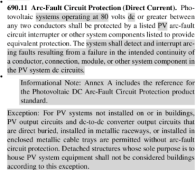OffGridInTheCity
Solar Wizard
Yes sir. In my case I have a cement tile 'shingle' roof under my panels on the roof, so that's some comfort in terms of fire catching easily and I don't have to replace the roof anytime soon.Series arc-fault was already handled by AFCI.
If a rodent chews through your wires and you get a parallel fault, it will arc.
Only fix we've identified is to plug those MC connectors into module-level shutdown. But your fireproof roof is a plus.
Remember pay phones? They had a metal loom around the handset cable. that should be fairly rodent-proof. Flexible metallic conduit?
CALPIPE S61000CTFX 1" STAINLESS STEEL FLEX CONDUIT 25' COIL | Gordon Electric Supply, Inc.
CALBRITE S61000CTFX 1FT SS316 STAINLESS STEEL BARE FLEX CONDUITwww.gordonelectricsupply.com






